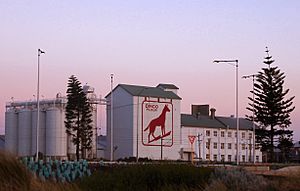Dingo Flour sign facts for kids
Quick facts for kids Dingo Flour sign |
|
|---|---|

The Dingo Flour sign
|
|
| General information | |
| Type | Sign on Flour mill |
| Location | North Fremantle, Western Australia |
| Coordinates | Lua error in Module:Coordinates at line 614: attempt to index field 'wikibase' (a nil value). |
| Official name | Great Southern Roller Flour Mill |
| Type | State Registered Place |
| Designated | 17 October 2008 |
| Reference no. | 3645 |
The Dingo Flour sign is a famous red picture of a dingo on the side of a large flour mill in North Fremantle, Western Australia. This mill is a historic building that still works today. The sign has become a well-known landmark in the area.
The mill complex is officially called the Great Southern Roller Flour Mills Limited. It was built in 1922. The site includes tall silos, an office, a laboratory, and other buildings. For a short time, there was another Dingo Flour mill in Narrogin from 1903 to 1912.
The Famous Dingo Sign
The Dingo Flour sign is much more than just an advertisement. It is a very important landmark for the community. The Heritage Council of Western Australia has said that the mill and its sign have a special "landmark quality." People have called it the "Dingo Flour Mill" for many years. This shows how much the dingo symbol means to the local people. It even has its own stories, like one myth that Alan Bond painted it.
Who Painted the Dingo?
The dingo logo was painted by an artist named Les Nash in 1940. He was paid £40 for his work. His daughter, Mona Rankin, shared that it took her father about a week to finish the painting. Les Nash first drew the dingo on graph paper. Then, he used the grid-like panels on the silo to help him transfer the design onto the huge building. The dingo is about five and a half storeys tall!
History of the Painting
During World War II, the dingo sign was painted over. However, its outlines could still be seen faintly. For many years, Refugees and migrants arriving in Fremantle would see the sign. It also helps boaters and anglers know where they are. The sign was mostly repainted in March 2001. The flour mill was updated in 2010, and the dingo sign is now repainted every month to keep it looking fresh and bright.
See also
- Borsari's Corner in Carlton, Victoria
- Nylex Clock in Cremorne, Victoria
- Pelaco Sign in Richmond, Victoria
- Skipping Girl Sign in Abbotsford, Victoria


